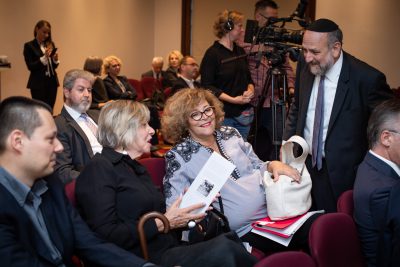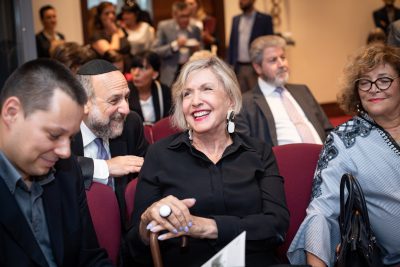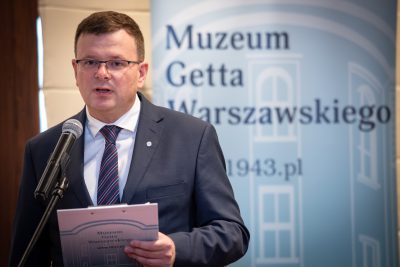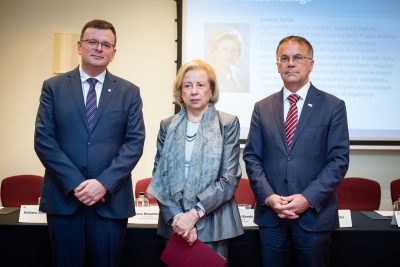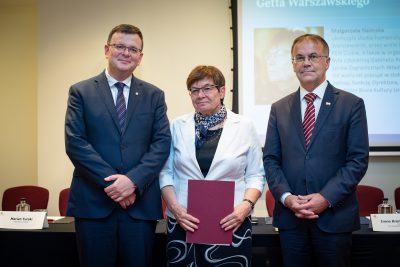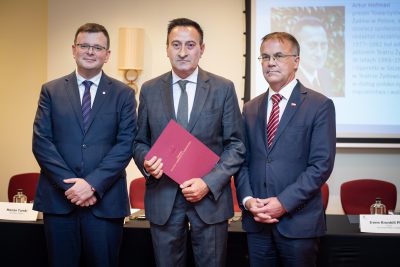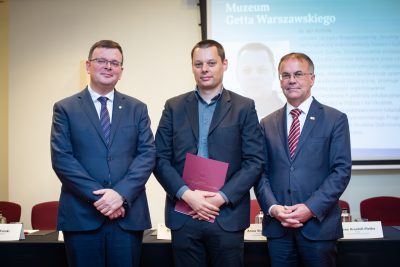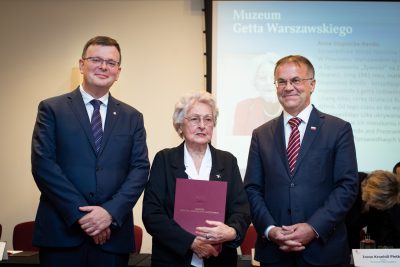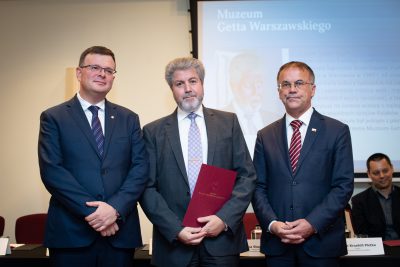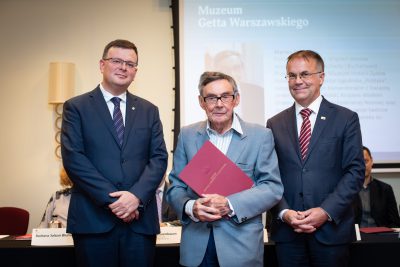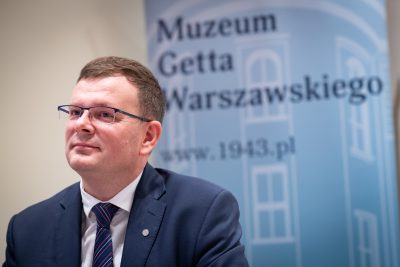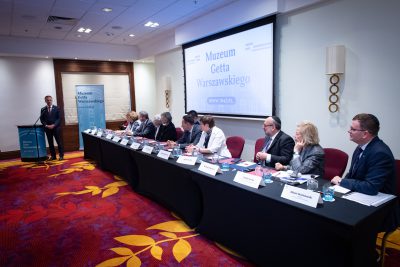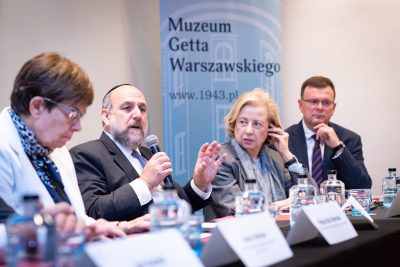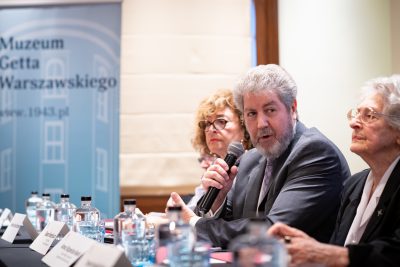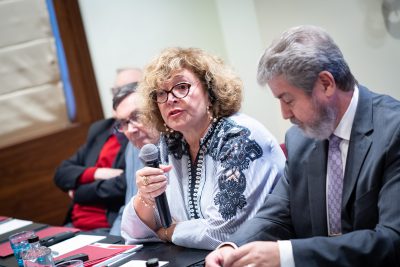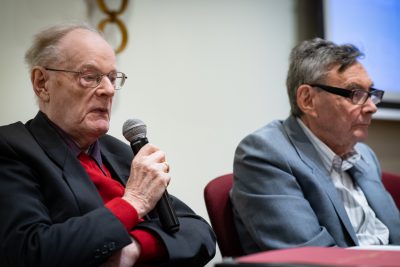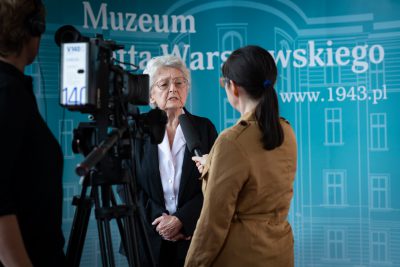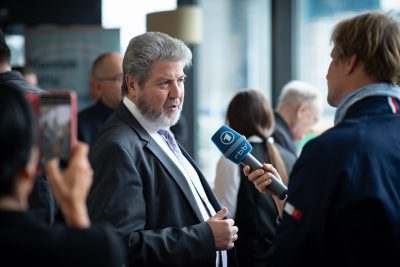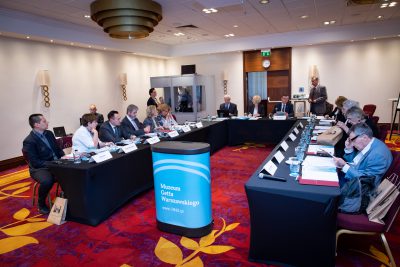The first meeting of the WGM’s Board of Trustees
Michael Schudrich, Chief Rabbi of Poland – Chairman of the Warsaw Ghetto Museum’s Board of Trustees, Małgorzata Naimska – Deputy Director of the Culture Office of the Municipal Office of the Capital City of Warsaw – Vice Chairman of the Warsaw Ghetto Museum’s Board of Trustees. During the first meeting, on 10 September, its members also designated the 15th member of their group. It is Jarosław Sellin – Secretary of State in the Ministry of Culture and National Heritage.
“We established a team led by an outstanding Holocaust historian, Prof. Daniel Blatman from the Hebrew University in Jerusalem,” reminded the WGM’s Director Albert Stankowski, opening the press conference of the Board of Trustees`s meeting. He pointed out that during the war, the Germans created more than 600 ghettos on Polish land, many of which have not been commemorated in any way. “I hope that our Museum, thanks to the help of our organiser, the Ministry of Culture and National Heritage and the State, will implement this idea of commemoration.”
Next, members of the international Board of Trustees, which include representatives of Poland, Israel, Germany, the United States, and Australia, were awarded their nominations. They were received by: Colette Avital, Bishop Mieczysław Cisło, Rabbi Michael Schudrich, Marshal Adam Struzik, Małgorzata Naimska, Artur Hofman, Dr. Jan Kutnik, Irene Kronhill Pletka, Anna Stupnicka-Bando, Gideon Nissenbaum, Barbara Blumenthal, Abraham Foxman, Marian Turski, and Wacław Kornblum.
Jarosław Sellin, Secretary of State in the Ministry of Culture and National Heritage, who took the floor after handing over the nomination notes, among others drew attention to the large number of institutions dealing with the Holocaust in Poland. He reminded that the idea of creating the Warsaw Ghetto Museum had appeared for the first time at the Jewish Historical Institute: “It was Professor Paweł Śpiewak who encouraged the Minister of Culture and National Heritage, Piotr Gliński and me, to create such a museum,” he said. He mentioned that the WGM has at its disposal, as the permanent headquarters of the permanent exhibition, the historic building of the Bersohn and Bauman Children’s Hospital, the only building that has remained intact from the period of the Warsaw ghetto. “I know from the programme that the story about Warsaw Jews will be very interesting,” Jarosław Sellin continued. “I hope that the Warsaw Ghetto Museum will work in a multifaceted way, perhaps even producing, as in the case of other museum institutions, a documentary.”
Each of the Board of Trustees’s members had the opportunity to present himself or herself in front of the gathered journalists and Museum staff. The first person to do so was the Israeli diplomat and politician, Holocaust Survivor Colette Avital, who in her homeland heads the Centre of Organizations of Holocaust Survivors, representing fifty organisations supporting the Survivors: “I am a Holocaust Survivor myself. I represent all of the Survivors in Israel. The establishment of the Warsaw Ghetto Museum can become a very important contribution (to commemorating the Shoah – editor’s note). The Warsaw ghetto is a symbol of death inflicted by the so-called human beings to other people, but also a symbol of dignity, creativity, resistance, and heroism.”
The Chief Rabbi of Poland, Michael Schudrich, emphasised that the Warsaw ghetto’s history is also unique to foreigners. “I was born on Long Island and the first thing I remember to hear as a kid was the story of the Warsaw ghetto.” The Rabbi said that it was our duty to build the best possible Warsaw Ghetto Museum.
Małgorzata Naimska, Deputy Director of the Culture Office of the Municipal Office of the Capital City of Warsaw promised assistance from the Municipal Office and mediation in all activities. “We would like Warsaw to be known in the world as a city where there was no ghetto before the war. So that is known that it was created by the Germans. So that Warsaw is a free and open city„.
Artur Hofman, Chairman of the Social and Cultural Association of Jews in Poland (TSKŻ), actor and editor-in-chief of Słowo Żydowskie said that for many years the TSKŻ has laid wreaths at the Monument to the Ghetto Heroes every year, on April 19, to celebrate the outbreak of the Warsaw Ghetto Uprising. “Historical knowledge is not the best these days. Places like the Warsaw Ghetto Museum must remind people who was the executioner and who was the victim.”
A member of the board of the „Well of Remembrance” Association, dealing with the documentation of the history and culture of Lublin Jews, reminded that the first museum in the world commemorating the Holocaust was the State Museum at Majdanek – the German Nazi Concentration and Extermination Camp, founded already in 1944, 75 years ago. He expects the Warsaw Ghetto Museum to propose new forms of commemoration.
Irene Kronhill Pletka, President of The Kronhill Pletka Foundation, which she founded herself, expressed hope that the WGM will not be just a historical museum, but that it will be able to create empathy for the history of both native Poles and Jews.
Anna Stupnicka-Bando, Chairwoman of the Polish Association of the Righteous Among the Nations wishes that the Warsaw Ghetto Museum recall the memory of “those days”. She told a story how, as a young girl, she would go to the ghetto together with her mum to smuggle a loaf of bread and some beet marmalade in a briefcase for a Jewish family with many children. “I remember how the children, very skinny, on the pavements, were dying of hunger right before my eyes. I can’t forget it.”
The President of the Nissenbaum Family Foundation, Gideon Nissenbaum, pointed out that he had a direct personal relationship with what had happened in the Warsaw ghetto through the figure of his father, Sigmund, the founder of the Foundation, who, together with his family was forced by the German decision to create a ghetto to stay in it. He also found himself three times at the Umschlagplatz and in the last transport to Treblinka. “We must go forward, look ahead into the future.”
“My parents had always told wonderful stories about Warsaw,” said Barbara Jolson Blumenthal, distinguished for saving Jewish heritage, founder of conservation works for monuments, daughter of a Holocaust Survivor, Warsaw-born engineer Leon Joselzon aka Jolson. “They met in Warsaw, fell in love with each other in Warsaw and got married here. I expect the Warsaw Ghetto Museum to tell about both the beauty of Warsaw and of the horrors of staying in this city during the war. About the true meaning of life and beauty and so that it teaches not to keep the harm inside.”
Marian Turski, editor of the Polityka weekly and Chairman of the Council of the POLIN Museum of the History of Polish Jews said: “On this land, a terrifying vacuum, great emptiness after this ethnic group, which the Jews had been, was created.” He stated that everything indicates that Jewish life will not be recreated in Poland and that is why every initiative going in this direction is very important. “The eyewitnesses of history are passing away. But the material witness that will remain is the hospital building (The Bersohn and Bauman Children`s Hospital – editor’s note). There is a chance that the Warsaw Ghetto Museum will reach young people.”
“The Warsaw ghetto is not history, but a part of my life. I was there, I lived there as a sixteen-year-old boy. My brother was born in the very building where the Warsaw Ghetto Museum’s permanent exhibition is to be created. I lived opposite him, at Śliska Street,” Wacław Kornblum said. He expressed his hope that the Museum would fill in the gap in commemorating the Warsaw ghetto, which POLIN Museum of the History of Polish Jews did not do sufficiently enough in its permanent exhibition.
At a closed meeting, the members of the Board of Trustees elected Michael Schudrich – Chief Rabbi of Poland as Chairman, and Małgorzata Naimska – Deputy Director of the Culture Office of the Municipal Office of the Capital City of Warsaw as the Vice Chairman. The 15th person to be a member of the Board of Trustees, namely Jarosław Sellin – Secretary of State in the Ministry of Culture and National Heritage was also designated. The Regulations for the operation of the Museum`s Board of Trustees were adopted. During the meeting, the programme of the permanent exhibition was presented and discussed.
Anna Kilian


